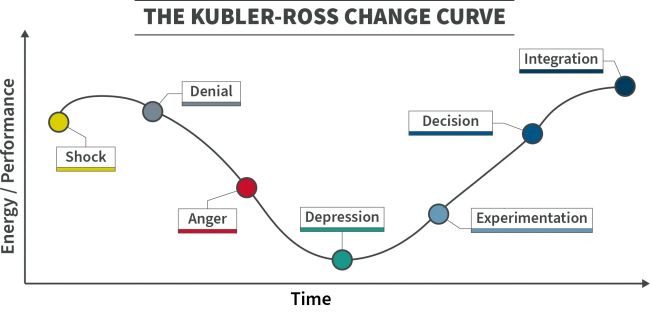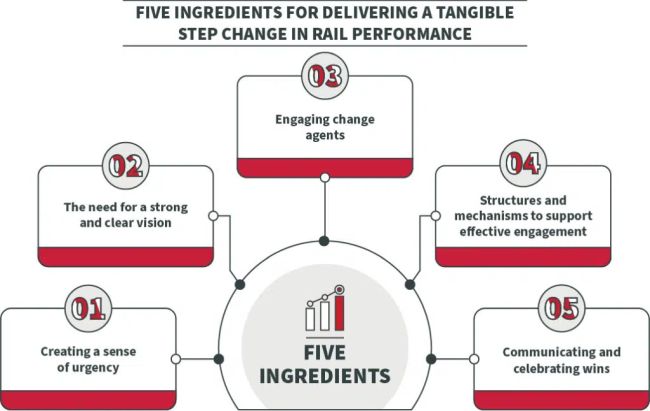As I shared in my recent video on creating the burning platform for change, if our rail industry is to successfully tackle the structural costs and change that is needed, it must create the necessary conditions that will motivate people to consider, assess and ultimately embrace the actions and changes that are required.
John P Kotter, the renowned Harvard Business School professor, lists the key reasons why business change programmes fail, and at the top of his list is 'Not establishing a great enough sense of urgency', which he says accounts for more than 50% of failed initiatives. This for me is the first ingredient in any successful change programme: creating the sense of urgency that overcomes the natural inertia to carry on as we always have.
Having talked to many senior leaders in the industry, I am astonished to hear, in this industry more than any other I have worked in, stories of middle management and front line workers simply saying no when asked to do things differently – even to senior management.
I draw on two live examples from recent discussions I've had with senior industry contacts: the CEO of one large rail organisation was simply told 'no' when asking a middle manager three levels below them to implement an agreed change. In another case, the employee of another large rail organisation told me, having rejected a change that he was asked to implement, 'they can't fire me anyway'.
Having worked in other sectors, this kind of behaviour would and could not go unchallenged, but is not uncommon to see in the rail industry.
To overcome this will clearly require creating a strong need and urgency for change, which critically includes explaining how this need for change will impact individuals at all levels. Looking at the Kubler Ross change curve, this 'burning platform' as I have described it is intended to help in taking the individual through the first part of the change curve: namely 'shock, denial and anger'.

A simple example of this for our industry today could be that the industry has a huge financial challenge and sits on significant inefficiency and cost locked into our current ways of working. There are huge opportunities to be more efficient and deliver better services and value for money, which will be critical in encouraging passengers to use our services. If we do not achieve this, the alternative is that services, investment and jobs will be cut and the industry will enter a spiral of decline.
This is, however, only the beginning of the journey and alone is not enough to bring individuals out of the 'depression phase' into experimentation and beyond. In my experience of working within and with the rail sector, in addition to needing to create a sense of urgency four other ingredients are required.
The first is the need for a strong and clear vision, a clear picture of a future world that is desirable and can be identified with. This is often a simple statement, but needs to then be translated into what it means to all parts of the organisation, including critically what the changes and benefits would be. The impact of this vision often provides a combination of removing the issue highlighted by the burning platform, combined with some positives, development of team, new technology, personal development or other. In our situation this could include achieving a financially sustainable railway, with growing numbers of happy passengers, world class services and technology, leading the way in terms of the decarbonisation of transport.
The important skill here is being able to explain what impact this could have on the various individuals/teams in question in a way that gives positive energy and brings people together. Without this there is a huge risk that the vision has no meaning or impact for many, leading to minimal impact.

The second ingredient is identifying and engaging some agents for change, in simple terms a group of well-respected individuals who embrace the change, provide challenge to the status quo and are ready to suggest and embrace new approaches and give confidence to others that this could actually work! This group are key in influencing others on an ongoing basis and ideally involve people at different levels in the organisation.
Thirdly, and often missed, is the need to create structures and mechanisms for teams to engage in creating and exploring ideas for change in a safe environment. Traditional 'good ideas' forums can be useful, but in the context of the need for a step change, a more structured approach that brings mixed teams together – armed with data and good facilitation, the absence of barriers to change, and with the freedom to brainstorm and explore how ideas could be trialled and implemented – is key to making this work.
Finally, ensuring that early on some change benefits and quick wins are achieved, that can be communicated and celebrated within the organisation. This can be the trigger for a sea change in acceptance of the initiative and lead to wider acceptance and support within the organisation. Without this, organisational fatigue and scepticism can easily set in, leading to loss of momentum and energy.
I do hope that this has provided some food for thought. Finally, I will leave you with a challenge: to consider if your organisation has all the ingredients in place and, if not, what you can do about it!
Originally published 15 March 2022
The content of this article is intended to provide a general guide to the subject matter. Specialist advice should be sought about your specific circumstances.

